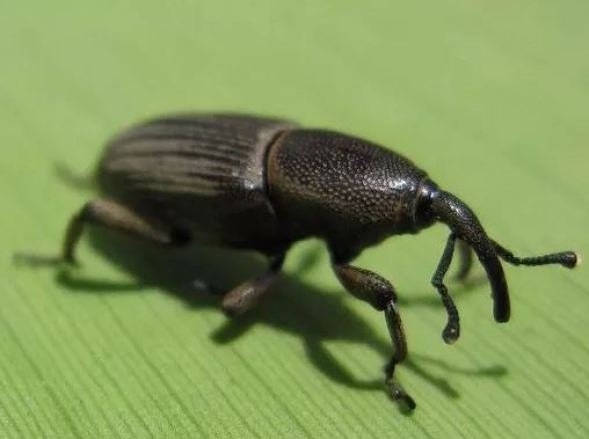Black Bugs on Plants: The Most Important Black Bugs

Hello to all agrohuerters! In today’s article we are going to learn how to identify which are the black bugs on the plants that appear in the orchard or garden.
Also, it is important to differentiate between black bugs that are harmful, pests, and those black bugs that are beneficial to plants. In this way we will be able to know when to apply the treatments or not.

Black bugs in the garden: the black aphid
As we have seen in other articles, there are many different species of aphids. Sometimes these species can change color due to the type of food and on other occasions the color is characteristic of the species to which they belong.
For example, the black bean aphid (Aphis fabae) is one of the aphid species that exhibit this color. One of the most characteristic damage of this species is the secretion of molasses, a sugary substance that can cause a possible subsequent attack by fungi.

Weevil
Weevils are other black bugs on plants that we can find. They belong to the order Coleoptera (beetles). The truth is that although they do damage to plants, they have a very nice appearance since their head is prolonged, forming a beak.
These insects mainly affect legumes, for example lentils. In addition, they are one of the most common pests in food stores.

Crop rotation, the use of screens or removing affected grains can be effective methods against the weevil.
Wireworm or Agriotes lineatus
This species causes damage especially when it has the «worm form», that is, before transforming into an adult. But it is important to know how to recognize what adults are like to detect problems in our crops. The adults are small black beetles.
The main damages caused by the wireworm are galleries in the tubers, damage to the roots, stems and seeds.

Thrips: black bugs on flowers
Thrips are one of the most common greenhouse pests. They can affect many crops such as tomatoes, onions, aubergines, fruit trees or houseplants. They are very small insects (between 1 and 3 millimeters) and can transmit viruses to plants.

ants on plants
Well, there is no need for me to put a photo of the ants because you know very well what they are like. We must not forget the special relationship that ants have with aphids. The honeydew produced by the aphids is loved by the ants and these, in turn, protect them from insects that want to eat them, such as ladybugs.
Beneficial Black Bugs: Ladybug Larva
We start with a classic in the world of beneficial insects: ladybugs. We are used to always seeing adult ladybugs when they are red, pretty and «they count our fingers two by two» (this last comes from a song).
However, we rarely see what the larvae of ladybugs are like, that is, the state of ladybugs before they become adults. It may be because its larval state is very different from its adult state. Ladybug larvae are black (with some orange spots), elongated, with legs and jaws.
Most importantly, both the adult ladybug and the larvae can eat many harmful orchard insects such as aphids.
Here’s a photo I took the other day so you can identify it:

If you want to have your own ladybug farm, check out this post on “ How to raise ladybugs at home ”.
Staphylinids
Staphinids are a family of beneficial insects belonging to the order Coleoptera (beetles). They are usually black to brown in color. They are elongated, not very large (from 1 to 35 millimeters) and with elongated antennae. They are also very curious insects because when you touch them they fold their tails as if they were a scorpion. In this way they can intimidate other insects.
Next, I leave you a photo that I took of one of them the other day with a microscope:

One of the best known species is Ocypus olens.
black beetles: carabids
Carabids are other beneficial black beetles that can help us with pest control.
They feed on small slugs or aphids. Like the previous cases, they belong to the Coleoptera order and differ from the rest because they have highly developed jaws with which they hunt their prey. In addition, another of their characteristics is that they move very quickly on the ground.
One of the best known species present in crops is Pterostichus melanarius. It measures around 20 millimeters and is black.

In addition to these species, you can find other beneficial organisms for the garden at the following link: « Beneficial insects for the garden «.
References
- Elliott, N.C., Kieckhefer, R.W., Beck, D. (2000).Adult Coccinellid Activity and Predation on Aphids in Spring Cereals. Biological Control, 173, 218–226.
- Riley, D., Sparks, A., Srinivasan, R., Kennedy, G., Fonsah, G., Scott, J., Olson, S. (2018) Chapter 3 – Thrips: Biology, Ecology, and Management. Editor(s): Waqas Wakil, Gerald E. Brust, Thomas M. Perring, Sustainable Management of Arthropod Pests of Tomato. Academic Press, 49-71.
- Foottit, RG, & Maw, HELBT-RM in LS (2017).Insects-Aphids. Elsevier.
This is all for today, I hope you liked the article and that from now on we know how to identify which are the black bugs on plants that are harmful or beneficial to crops. Do not hesitate to send us photos in the comments of the black bugs that you find.
Have a nice day!

![Photo of Jericho Flower: [Cultivation, Care, Pests and Diseases]](https://www.complete-gardening.com/wp-content/uploads/2022/08/jericho-flower-cultivation-care-pests-and-diseases-390x220.jpg)


![Photo of Starfruit: [Cultivation, Irrigation, Care, Pests and Diseases]](https://www.complete-gardening.com/wp-content/uploads/2022/08/starfruit-cultivation-irrigation-care-pests-and-diseases-390x220.jpg)